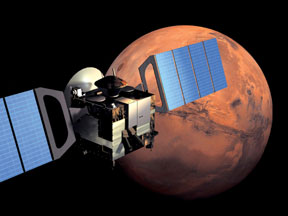This is a picture by an artist of the Mars Express spacecraft flying towards Mars.
Click on image for full size
Image courtesy European Space Agency (ESA) - Illustration by Medialab
Overview of the Mars Express Mission
The European Space Agency (ESA) launched a mission to Mars called "Mars
Express" in June of 2003. The Mars Express spacecraft has two parts:
an orbiter that
will circle the Red Planet for at least one Martian year (687
Earth days),
and a lander
named "Beagle 2" which is scheduled to touch down on the
surface of the Mars on December 25, 2003.
Scientists are searching for water on Mars because they think that if
they find water that would be the best place to look for life. Mars Express
has a radar that can look through rock. Scientists hope to find water
underground on Mars using the Mars Express' radar. The spacecraft will also take pictures
of Mars and study the Martian atmosphere.
The Beagle 2 lander will try to find life on the surface of Mars. It has
a robotic arm that will scoop up soil. It will find out what kinds of chemicals
are in the soil. Some types of chemicals are mostly made by living creatures.
If Beagle 2 finds those types of chemicals it will have strong evidence
that it might have found life. Beagle 2 will land in a flat area called "Isidis
Planitia" that is inside
an old crater. There may have been a lake inside the crater many years
ago.
Beagle 2 is named after a famous ship, the H.M.S. Beagle. A scientist
named Charles Darwin sailed
on the H.M.S. Beagle in the mid-1800s. Darwin was one of the first scientists
to explain how evolution works. The theory of evolution is very important
in the science of biology. If scientists find life on Mars with the Beagle
2, that would be a very important discovery for the science of biology,
too. That is why the Mars Express mission planners decided to name their
lander after Darwin's ship.
You might also be interested in:

How did life evolve on Earth? The answer to this question can help us understand our past and prepare for our future. Although evolution provides credible and reliable answers, polls show that many people turn away from science, seeking other explanations with which they are more comfortable.
...more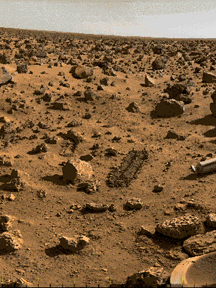
When we ask "Where might we find extraterrestrial life", the first place many scientists turn to, because of its similarity to the Earth, is Mars. Mars may have been like the Earth in its past. Although
...more
Most of the water we see each day is in ponds, rivers, oceans, streams, lakes, puddles, and other places on top of the ground. What we don’t often see is the water that soaks into the ground. Water that
...more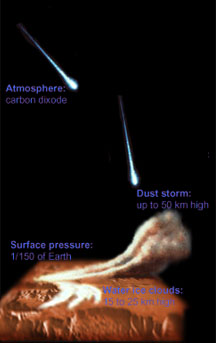
The atmosphere of Mars is much thinner than that of Earth, with a surface pressure averaging 1/100th that at the surface of the Earth. Surface temperatures range from -113oC at the winter pole to 0oC
...more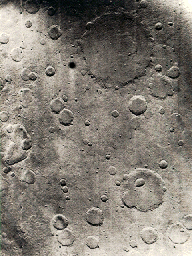
This is an example of the cratered surface of Mars. Almost the entire surface of Mars is covered with craters. Craters can be wiped out over time, so a surface which has many craters is very old. The lowlands
...more
Charles Darwin was an English Naturalist who lived between 1809-1882. He laid the foundations for the modern science of biology, and changed how other scientists understood the appearance of life on Earth.
...more
Since 1960, the Russian and American space agencies have sent many spacecraft to Mars. Some have been a great success while others didn't even make it into space! Mariner 4 was the first mission to make
...more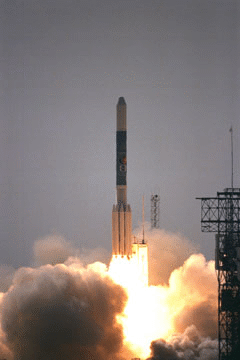
The Advanced Composition Explorer (ACE) was launched at 10:39 a.m., August 25, 1997. The ACE was launched aboard a Delta II rocket. Mission lifetime is expected to be five years for the overall mission.
...more


